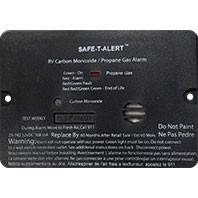Affiliate Disclosure: I earn commissions if you shop through the links below at no additional cost to you.
Last Updated on January 27, 2024 by Jeremy
Having an alarm in an RV that detects carbon monoxide and propane gas is extremely comforting, in the aspect that knowing you are safe from dangerous gases that could potentially harm or kill you.
Safe-T-Alert RV Carbon Monoxide Propane Gas Alarm, is a product brand, which is a detector and alarm that was manufactured by a company called MTI Industries.
Of the many models and products MTI has manufactured in the Safe-T-Alert brand, I will be focusing on model 25-742, which is a dual LP / CO alarm which is a flush mount product and comes with an attached trim ring.

Safe-T-Alert RV Carbon Monoxide Propane Gas Alarm
Product Name: 25 Series Flush Mount Mini – Dual LP / CO Alarm
Product Website: MTI Industries
Pricing: $123.20
Personal Rating: 6/10
How Product Works
To truly understand how a carbon monoxide and propane gas detector work, we first need to understand what carbon monoxide and propane gas are, and how they act for a detector to detect it.
Carbon monoxide is what we learned in science class, and is a denser than air, flammable gas that has distinct properties which include:
- -Tasteless
- -Colorless
- -Odorless
- -Poisonous
What is usually the culprit of when fire is introduced into your living space, carbon monoxide exists its presence around an open flame. Coincidentally, in a boat or RV, travel trailer or 5th wheel trailer, the presence of carbon monoxide is accompanied with a propane stove or furnace.
Introducing Propane, a distinctively smelling gas that is supplied from your tank to said propane stove or furnace.
Now, both of these gases are most definitly poisonous if undetected, so an introduction of an alarm to detect these gases was introduced into businesses and homes, so that it can potentially save the lives of hundreds and thousands of people every day.
How a CO detector works in general, is that a sensor inside the unit triggers an alarm from high levels of CO that are in the air. The same applies for propane, which both gasses typically hover at a lower level than what we would breathe at a higher level. You can ideally read an in-depth article about how a CO monitor works by visiting this website: How Do Carbon Monoxide Detectors Work? – Alarm Grid
This particular model works the same way as described above, and other models, that come with relays, sound an alarm and turns your gas supply off when a propane leak is detected.
Example Video – How to Test Your CO / LP Monitor
A primary key piece of advice is to ensure your monitor / alarm is consistently working properly, therefor one must test it at regular intervals. The video below, will show you how on a different model number, but the concept is the same for each model:
FAQs, Specs & Features of the Product
The 25 Series Flush CO / LP alarm comes in the colors white or black, and should be installed in your RV or travel trailer, closest to the RV appliances such as a stove or furnace, only if space permits it to. See an example below:

Some units may already have these alarms installed in other locations, and that is perfectly functional as well.
The features of this particular model include:
- 12V Power – no batteries to replace.
- Meets RVIA/NFPA requirements.
- Compact design.
- Alarm Mute Button – Will silence the alarm if trailer is ventilated, but will reset and reactivate if levels are still dangerous.
- Ideal for all RV units including – Class A Motor homes, Class B Van Campers, Class C Mini-Motor Homes, Travel Trailers, Fifth Wheels, Truck & Folding Campers.
- Detects both gas leaks and CO gas simultaneously.
- Dimensions – 7″W x 4″H x .5″D
Warranty, Pricing, and Option to Purchase
Now, rule of thumb that I have encountered regarding warranty is, that after 5 years, you should always replace your CO detectors due to the possibility the sensor will become “poisoned”. I will get into this later, but like other products, and including smoke detectors, these units have replacement dates on them for every 5 or 10 years, and this is due to that exact reason I just mentioned.
What I mean by poisoned, is that the sensors that detect built in to the units, over time will get contaminated air particles introduced to it, in forms of dust, grease, or other debris that adheres to this surface. This in turn, weakens the sensor, and could potentially expose it to setting off more frequently than its used to.
On a battery operated model, this can be also similar, so it doesn’t much matter whether the detector is 12V or battery operated.
To fix this, just purchase a replacement model, and that will continue to keep the warranty of these products intact, especially if purchased from a store front. You can read where to purchase certain RV parts and accessories by reading this article: Where is the Best Source for RV Parts and Accessories?
As mentioned earlier, I have this particular brand and model number priced out at $123.20. This is only available through the direct link of the MTI website. Here’s the bad news: They probably have them sold out by now, and every resource I’ve found is running low on stock or doesn’t exist anymore, so finding one now would be a miracle.
Not to fret, the good news is that there is a Universal Replacement as of the original post date in this article that has been manufactured, and its new model number is 85-741, with the dimensions measuring 7″H x 4″H x .75″D.
This brand new design replaces all brands/models of LP gas detectors and dual CO / LP gas alarms, which still detects both gas leaks and CO gas simultaneously. The difference is its new low profile and slim design, which is still built for the extreme RV environment.

Conclusion / Final Thoughts / Personal Opinion
Giving a re-cap, the 25 mini series Safe-T-Alert carbon monoxide propane gas detector is (or was) a really good model to have to detect poisonous gasses, and potentially save you from extreme harm or death.
One personal story I’d like to share with this particular brand is that sometimes they can have “false alarms“. What I mean is that certain products and smells have triggered the sensor to assume that there were traces of potential harmful odors within the RV, but that in fact was not the case.
I’m uncertain how many of you have had this happen, where you woke up in the earliest hours of a deep sleep from the loud sound of your CO / LP alarm going off only to rush up, open doors, and hit the mute button.
This has happened on more than one occasion with our brand and upon determination we discovered through research and testing what the causes have been.
- -Air Fresheners / Air Cleaning Products such as Febreeze or Lysol
- -All-Purpose Cleaners (certain brands)
- -Dust / Grease (weakened sensor)
- -Flatulence
That’s right, farts are a cause for your detector to go off, and this is another reason why these sensors inside get “poisoned”. The unfortunate part after realizing this, is no matter the expiry date on your product, it needs to be replaced or serviced by a dealer. Taking these things seriously, no matter how funny it may seem, is not worth the risk.
That said, knowing this particular version does not exist, is the reason why my overall score is as low as it is, but knowing it has a replacement model in existence, makes it more of a relief.
Also knowing that if you are still in a panic, and don’t really care if there is a replacement or not, that you just want a new co2/propane alarm – fear not! There is one availavle on our store:
This concludes my review of model 25-742, and I am happy to answer any questions you may have about this product, by leaving your comments below. Cheers!




.jpg/:/cr=t:5.56%25,l:0%25,w:100%25,h:88.89%25/rs=w:1240,h:620,cg:true)



Leave a Reply